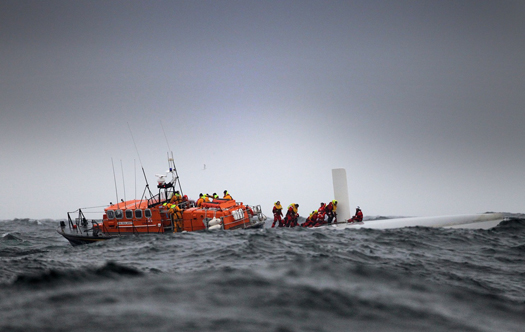#sywoc – When something seems just too good to be true, it usually is. But just now and again, though only very occasionally, it is good and it is true.
On Wednesday evening, followers of the Irish team in the Student Yachting Worlds at La Rochelle in France were in a state of wonderment and hope. Could it really be that, after 13 races and a "Stewards' Enquiry", UCD were actually leading overall by all of 12 points?
And after all the disappointments at the final hurdle in so many international sailing events this year, could it possibly be the case that with just two more races to sail, admittedly in a decidedly hot fleet, could it be that Cathal Leigh-Doyle and Aidan McLaverty and their crew of ten could hang onto their lead right through to the prize-giving today – after all, it only needed them to be just one tiny little point clear?
In such a situation, first thing is a look at the weather prospects. Mostly the breezes in the region were fresh west to southwest, but the forecast charts showed a bullet of stronger wind barreling its way up the Bay of Biscay, right on line for La Rochelle through Thursday and yesterday.
Initially it didn't look too rough, but then we got to thinking that they'd go out to race in tough conditions, and UCD might get dismasted. That's the way you get to think after a season of disappointments like 2012. But the ill wind blew Ireland good. It arrived as a gale, and further racing was eventually cancelled. We were home and dry.
It had been an excellent series already, and the Irish team had excelled both inshore and offshore. For part of this week, they were racing in the knowledge that points gained in the second race had been lost through an alleged start line infringement. But eventually an official analysis of video evidence showed Ireland to be all clear, and with the points reinstated they moved into this massive overall lead.
"Massive overall lead", however, has been the bugbear of Irish international sailing this year. Get one early in any major series, and the opposition will naturally gang up on you. But thanks to the weather, this time they didn't have the opportunity, and in truth it's difficult to see what they could have done anyway, short of outright sabotage.
Our team were Cathal Leigh-Doyle, Aidan McLaverty, Barry McCartin, Ben Fusco, Simon Doran, Theo Murphy, David Fitzgerald, Ellen Cahill, Isabella Morehead and Alyson Rumball. They come from every corner of Ireland, they represent virtually all the main sailing centres and many smaller ones throughout the country, and they've all done us proud.
Amidst this deserved euphoria, there's no better time to put the record straight on Ireland's scorecard in student world championships, about which we've all been a bit confused, not least this column.
The Student Yachting World Cup is now top of the bill, but although it was founded back in 1979, another competition in France tried to claim its crown. That was the Course de L'Europe at Le Lavandou in the south of France, which had a greater emphasis on offshore racing. In 1988, Trinity College Dublin took part representing Ireland, and they placed third overall out of twenty national teams, an impressive fleet which the current competition has not recently matched. The Irish team nearly a quarter of a century ago was Gary MacCarthy, Paddy Oliver, Sean Hooper, Sarah Webb, Helen Cole, Jamie McWilliam and Roger Morris, with Glen Reid as manager.
Fast forward eighteen years, and in 2006 Trinity are again Irish champions, and this time they're racing in the Student Yachting World, staged as usual at Hallowe'en, and on that occasion at Lorient. They won. By 2008, Irish university interest in the SYWoC is growing every year, and taking part in it is regarded as the peak of our inter-collegiate sailing. That year, Cork Institute of Technology with Nicholas O'Leary as skipper are Irish champions, and they go on to win the SYWoC at La Trinite, giving it an even higher level of national interest back home.
The story since 2008 is part of Irish sailing lore, and UCD's very thorough and successful campaign towards this year's victory is eloquent testimony to the remarkably high level of university sailing in Ireland. This is good news morning.
WILL YOUR BOTTOM LOOK BRIGHT ENOUGH IN THIS?
One of the interesting points to emerge from this week's report into the capsize of Rambler 100 in last year's Fastnet, and the subsequent successful rescue of her large crew, is the suggestion that boats which are liable to invert might usefully have their bottoms coated with high visibility paint.

Rambler 100s upside down hull was hard to spot. Photo: Team Phaedo
For all her great size, the capsized Rambler was remarkably difficult to spot on that grey evening, as her upturned white hull was easily mistaken for a breaking wave.
It sounds like a neat idea, but some agreed definition of boat that is likely to capsize would be a necessary starting point. After all, having a dayglo orange bottom will amount to a statement that your boat is pushing the envelope of lightness and exceptional ballast leverage to the absolute limit, upon which all old salts will say that it's damned unseamanlike, and shouldn't be permitted out of the harbour in the first place.
Then too, which particular shade of dayglo would sir or madam prefer? While extremely useful and indisputably life-saving, when considered purely as colours they're all horrible - in fact, the more horrible, the more effective they become.
Time was when all sorts of notions attached to the different colours of anti-fouling bottom paint, and as most of them change in shade as the season progresses, all sorts of debates are possible on which is the more effective, and at what time in the year.
In the old days, the feeling was that only red anti-fouling was effective – it was something to do with the lethal chemicals which could be successfully incorporated in red. Black was also supposed to be okay, but not blue, and – surprisingly – not brown, despite its relative closeness to clean copper. But of course green like weathered copper was and is much approved – it's what I use myself, but it has to be admitted that's mainly because I simply like the look of it.
One colour which used to be regarded as wellnigh impossible was white, which made it a challenge for amateur chemists. Back in the day when boats were still kept in Ballyholme Bay, I can remember as a kid that the annual launch of the little keelboats of the Bay Class used to see the slipway area kept clear for one boat which would arrive without the anti-fouling already applied. She would be set up ready for launching at the top of the slip, and then the owner would arrive at high speed on his bike, with the carrier loaded with cans of white anti-fouling to his own recipe which he'd been mixing at home in the kitchen, This anti-fouling would be applied in jig time, and the boat then was hurled down the slip into the water, as the magic brew was supposed to lose its potency in fresh air even more quickly than standard anti-foulings.
It looked very smart - white topsides, red boot-top, and white bottom – but the boring boats with the red anti-fouling were always winning by mid-season. But then, in those days antibiotics weren't part of everyday life. Today you'd be regarded as anti-social and an ecological hooligan if you put veterinary anti-biotics into your anti-fouling, but it works.
And I'm told essence of horseradish works quite well too. But this seems to be taking us away from the subject of the colour of boats' bottoms for safety purposes. So maybe we should be talking with our neighbourhood whales. Seafaring lore would have it that whales tend to attack boats with white or red bottoms, but will leave blue, black or green alone. So what are whales likely to make of the heroically revolting dayglo lime, let alone the standard dayglo orange?
































































